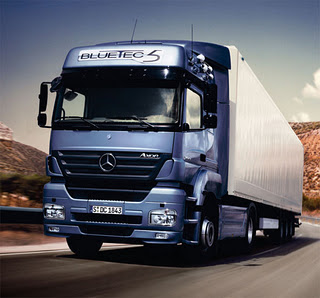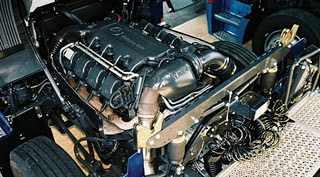 Just as in all global markets, there is a major debate going on in the US as to which technology needs to be adopted – SCR Vs EGR.
Just as in all global markets, there is a major debate going on in the US as to which technology needs to be adopted – SCR Vs EGR.
There is a lot of debate going around the world on which engine technology to adapt for reducing emission – SCR or EGR. The US EPA 2010, which is the equivalent of Euro emission norms, calls for a further and final NOx reduction that is 99 percent lower. It means all 2010 heavy truck diesel engines will have near-zero emissions of particulates and NOx.
Daimler Trucks North America has chosen Selective Catalytic Reduction (SCR) as the technology path for 2010. SCR is a technology that has been thoroughly tested and proven in real world applications. Daimler alone has already over 100,000 trucks in operation using SCR in Europe, and it has proven itself to be sound and effective. Most importantly, it delivers exactly what it is supposed to cleaner emissions, improved economics, and reliable performance in the harshest environments, hot or cold. SCR utilizes diesel exhaust fluid (DEF) which is simply automotive grade urea, or what’s known as AdBlue in Europe. Emissions impact
Emissions impact
We hear a lot about how emissions negatively impact the ozone and contribute to global warming. But the direct health impacts of diesel are also a concern. NOx contributes to smog, and smog contributes to more than 400,000 hospital visits every year for conditions related to asthma, respiratory and heart disease. All of this has been linked to diesel exhaust. According to the Clean Air Task Force, more than three-fourth of all Americans live near concentrated sources of diesel exhaust.
We are committed to reducing total emissions from our engines to the lowest possible levels. We also have a goal to provide truckers sound business solutions as well as to produce the most fuel-efficient trucks on the road.
Technology challenge
Development for EPA 2010 is upon us, and with it comes the most stringent requirements for near-zero levels of NOx to date. It’s no secret that Daimler Trucks, a company with extensive expertise in the development of virtually all of the various truck engine technologies worldwide, has clearly chosen SCR. Why did we make this choice? It’s because SCR works for everyone, it works for OEMs, it works for truck customers, and it works for the EPA.
We can hit the most stringent emissions targets and hit our reduced fuel consumption targets at the same time. This happens because every component in the system is allowed to be optimized in doing what it does best.
To better understand the importance of this, let’s take a moment to look at exactly how SCR and non-SCR engines work.
To be fair, EGR – exhaust gas recirculation – can reduce nitrogen oxide out of the tailpipe. But without SCR, the significant reductions in NOx required for the next EPA round will attempt to push engine technology further than it’s ever been pushed before. Increases in exhaust recirculation, heat rejection and altered combustion processes demand trade-offs we’re not willing to make.
I’m not saying it can’t be done, but we know that basic physics will create some challenges relative to heat rejection, particulate build-up and fuel consumption that must be overcome somehow. Without after-treatment in the exhaust stream, whatever NOx comes out of the engine is by definition what comes out of the tailpipe.
This means the engine itself must do all of the work of NOx reduction whatever the performance impacts may be.
In the case of SCR, the engine is focused on only one thing: optimal performance for pulling freight. There is no other objective. Optimizing engine performance, however, favors the production of higher levels of nitrogen oxides. Enter the Selective Catalytic Reduction system. SCR allows the engine to be configured to relatively high nitrogen oxide raw exhaust emissions, which are then effectively eliminated by injecting DEF into the exhaust stream. The result?
* The engine stays focused on producing efficient power and torque over a long life, without also having to reduce emissions. This enhances fuel efficiency.
* Engine optimization reduces particulate output and, as a result, the particulate filter needs less regeneration, further enhancing fuel efficiency.
* Then, the SCR catalyst focuses upon reducing NOx in the exhaust stream. That’s all it does, and it easily hits even the lowest emission requirements.
Each technology component is optimized by focusing on what it does best. Particulate and NOx are efficiently handled, without stressing the engine itself. That means the engine runs better, stays cooler, and lasts longer. We already know from experience that the technology is extremely reliable. That’s why from the perspective of most of the worlds OEMs today, it’s ideal.
SCR works for customers
But how about from our customers’ standpoint? In an environment where fuel economy is increasingly critical, it is the ultimate solution. Both testing and real world operations in Europe are showing 3-5 per cent improvement in fuel economy. Some customers are reporting more. There is no reason we can’t expect similar results here. Considering how hard we work for each and every percentage, and what it’s worth given today’s fuel prices, we know that’s significant to our customers.
The EPA loves SCR because we can hit the specific, near-zero emissions targets at the tailpipe without degrading fuel economy. Perhaps recent comments about SCR from one of the EPA’s leading experts sums it up best when he said: “It’s been decades since government requirements led to the introduction of technology that is as good for business as it is good for the environment.”
As we said, SCR works for everyone. Ok, we said there were pros and cons, and these are all pros. but to be fair, the cons fall mainly into one category – yes, you must add DEF, or “AdBlue” as they call it in Europe.
This concern seems to have two parts. First there is the concern that this will be a hassle. But this just hasn’t been the problem many anticipated. Since AdBlue is lower in cost than diesel fuel, and offers lower operating costs and increased durability. Customers we’ve talked to in Europe feel that it more than makes up for any minor inconvenience. The customers we talk to in North America say if we can deliver on the same promises here that we did there, they won’t care either.
We are certain, after building and seeing the results of operating more than 100,000 BlueTec SCR clean diesel trucks, that it is performing.
SCR growth and understanding will be driven in part by applications outside of trucking. The technology is commonplace today in cleaning emissions from power plants. SCR cars and light trucks will also be hitting the highways this year.
In fact, SCR is expected to dominate the light trucks scene, and may represent as much as 15 per cent of car sales in the US within just a few years. Clean diesel was all over the Detroit auto show this year, with SCR playing a leading role. Volkswagen, Jeep, Hyundai, Kia, Audi and BMW all had SCR
vehicles on display, in addition to Mercedes.
In 2004, the Association of the European Automobile Manufacturers (ACEA) and the VDA – the association for heavy duty trucks – publicly agreed in Hanover that SCR: “is the only possible way to reduce exhaust gas emissions, optimize engine performance and improve fuel economy (up to 3 per cent) at the same time.”
Current trend
Today, Europe is equipping its trucks with SCR technology at an incredible pace. Current reports show new truck additions (registrations) averaging 25,000 trucks per month. In just two short years, between 2006 and 2008, the industry grew from 30,000 vehicles to more than 500,000 heavy duty SCR trucks. And reports show the SCR adoption rate is continuing to climb as more and more companies upgrade their fleets.
As we look toward the more stringent performance requirements ahead, SCR makes even more sense, especially with fuel prices at an all-time high. Being able to say you have the cleanest possible diesel technology while simultaneously pocketing 3-5 per cent in fuel savings is simply too good to pass up.
“To sum up, we are 100 per cent committed to bringing our customers the best trucks for business and the environment, and we’ve invested heavily to get there. What we began with the advanced aerodynamics and cooling of the Cascadia, and further advanced with the DD15’s turbo compounding and ACRS fuel system, we will advance yet again with the introduction of our next generation BlueTec, SCR clean diesel in 2010. All of these elements – truck, engine, and emissions technology – were designed to operate together as a single, integrated system. That means better fuel efficiency, better cooling, better performance all round.